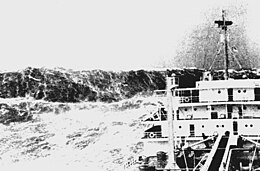
Back موجة مارقة Arabic Qatil dalğaları Azerbaijani Onada gegant Catalan Rogue wave Czech Вĕлеревçĕ-хум CV Ekstrem havbølge Danish Monsterwelle German Giganta ondo Esperanto Ola gigante Spanish موج عظیم Persian
This article may require copy editing for grammar, style, cohesion, tone, or spelling. (August 2023) |

Rogue waves (also known as freak waves, monster waves, episodic waves, killer waves, extreme waves, and abnormal waves) are huge and unpredictable surface waves that can be extremely dangerous to ships and isolated structures such as lighthouses.[1] They are distinct from tsunamis, which are often almost unnoticeable in deep waters and are caused by the displacement of water due to other phenomena (such as earthquakes). A rogue wave at the shore is sometimes called a sneaker wave.[2]
In oceanography, rogue waves are more precisely defined as waves whose height is more than twice the significant wave height (Hs or SWH), itself defined as the mean of the largest third of waves in a wave record. Rogue waves do not appear to have a single distinct cause but occur where physical factors such as high winds and strong currents cause waves to merge to create a single huge wave.[1] Recent research suggests sea state crest-trough correlation leading to linear superposition may be a dominant factor in predicting the frequency of rogue waves.[3]
Among other causes, studies of nonlinear waves such as the Peregrine soliton, and waves modeled by the nonlinear Schrödinger equation (NLS), suggest that modulational instability can create an unusual sea state where a "normal" wave begins to draw energy from other nearby waves, and briefly becomes very large. Such phenomena are not limited to water and are also studied in liquid helium, nonlinear optics, and microwave cavities. A 2012 study reported that in addition to the Peregrine soliton reaching up to about three times the height of the surrounding sea, a hierarchy of higher order wave solutions could also exist having progressively larger sizes and demonstrated the creation of a "super rogue wave" (a breather around five times higher than surrounding waves) in a water-wave tank.[4]
A 2012 study supported the existence of oceanic rogue holes, the inverse of rogue waves, where the depth of the hole can reach more than twice the significant wave height. Rogue holes have been replicated in experiments using water-wave tanks but have not been confirmed in natural bodies of water.[5]
- ^ a b "Rogue Waves – Monsters of the Deep: Huge, freak waves may not be as rare as once thought". The Economist. September 17, 2009. Retrieved 2009-10-04.
- ^ "What Is a Sneaker Wave?". WorldAtlas. 3 April 2019. Retrieved 2020-07-29.
- ^ Häfner, Dion; Gemmrich, Johannes; Jochum, Markus (20 November 2023). "Machine-guided discovery of a real-world rogue wave model". Applied Physical Sciences. 120 (48). doi:10.1073/pnas.230627512. Retrieved 5 June 2024.
- ^ Chabchoub, A.; Hoffmann, N.; Onorato, M.; Akhmediev, N. (Jan-Mar 2012). "Super Rogue Waves: Observation of a Higher-Order Breather in Water Waves". Vol.2, No. 1. Physical Review. Retrieved 23 June 2023.
- ^ Cite error: The named reference
MyUser_Onlinelibrary.wiley.com_April_16_2016cwas invoked but never defined (see the help page).